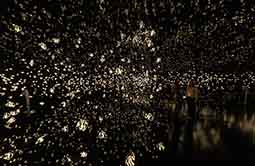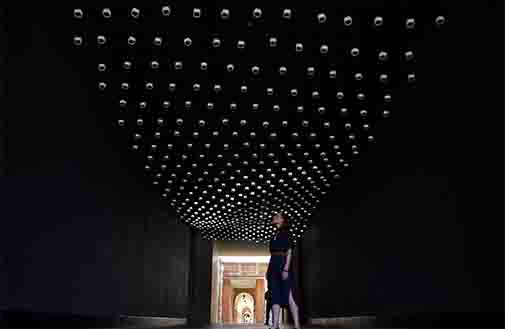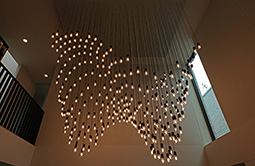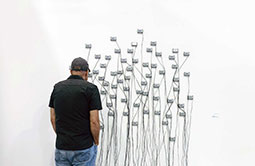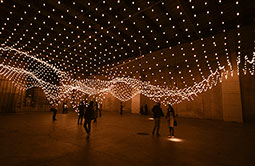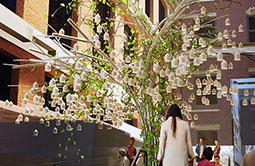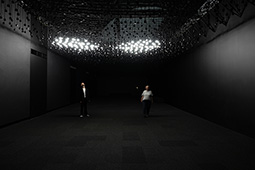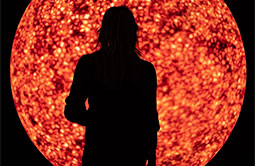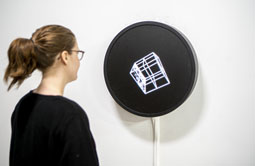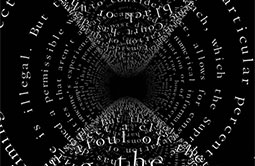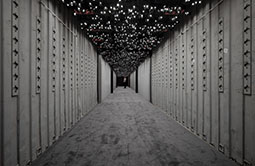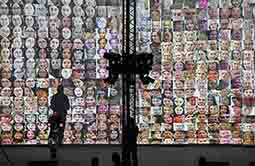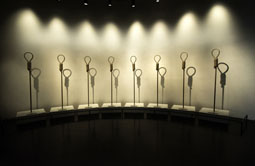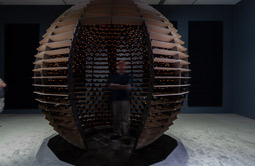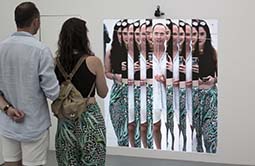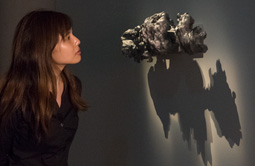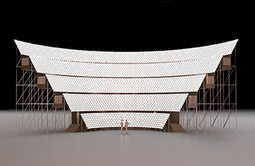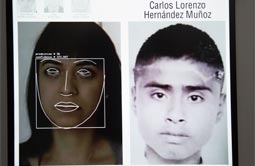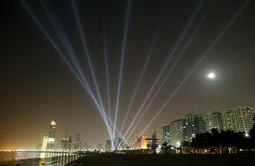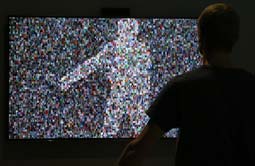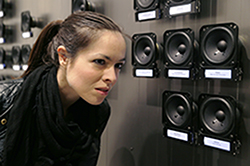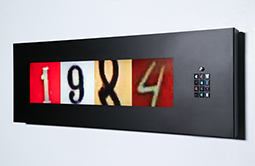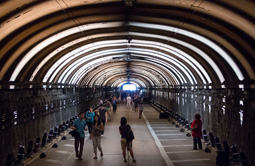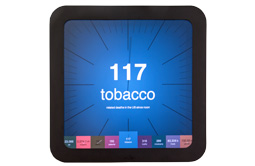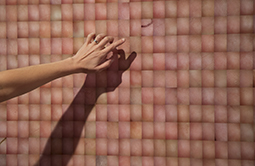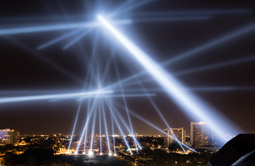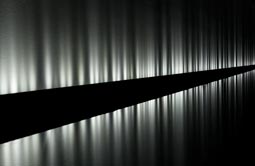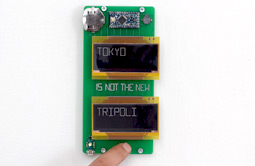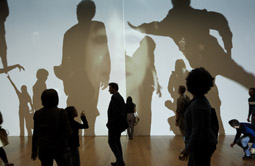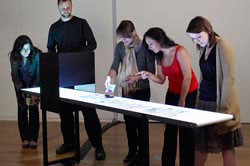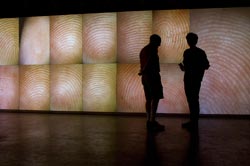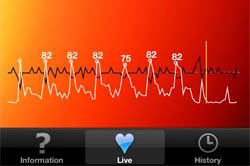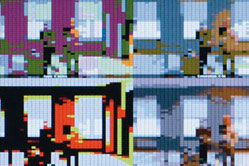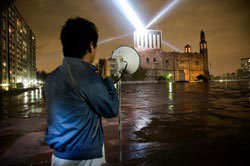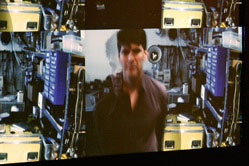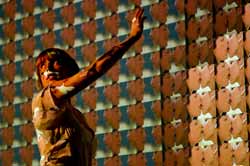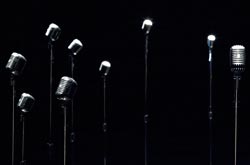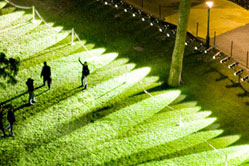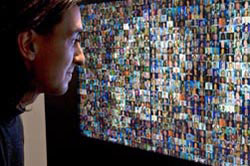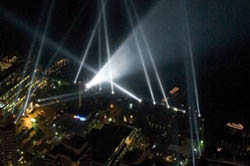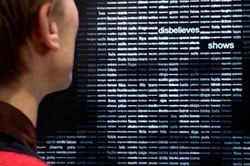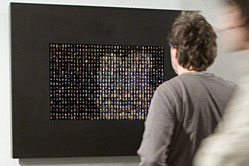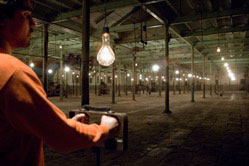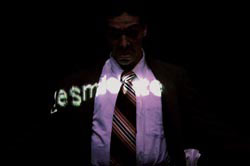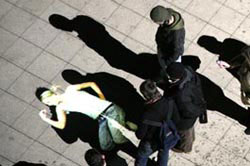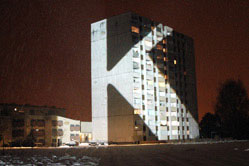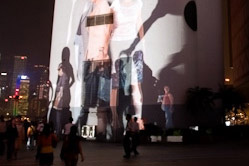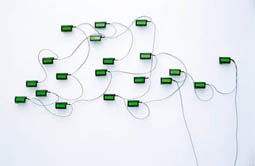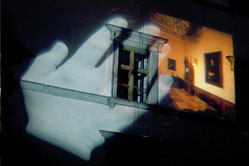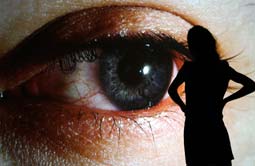Pulse Voronoi
2024
One cubic metre of crystal explodes into 7,000 unique but complementary shards, expelled in all directions. "Pulse Voronoi" proposes a walk through the resulting cloud of crystals, shortly after the blast. The crystals are suspended in the room, each with a warm light that glimmers rhythmically to the recorded heartbeat of a different participant from the past. Five pulse sensors placed around the room detect visitors' heartbeats which can be heard in the room and seen in surrounding lights. Every new recording of vital signs deletes the oldest one, creating a memento mori.
View details.
View details.
Kristallstimmen
2024
An interactive installation for Swarovski’s “Crystal Worlds Museum” in Wattens, Austria, features an array of 3,000 suspended loudspeakers, each clad in hundreds of small black crystals that get illuminated when in use. As visitors traverse the space, sensors detect their presence and turn on the speaker directly above them, which lights up and plays a voice message. Each loudspeaker contains a recording from a different company employee from around the world, speaking in their native language about their relationship to crystal, with over 100 languages represented. When no visitor is present, the installation is silent.
View details.
View details.
Recurrent Lloyd Wright
2024
“Recurrent Lloyd Wright” is a recursive algorithmic animation that draws together the vast corpus of Frank Lloyd Wright’s “Usonian” architectural blueprints and evaporates them into a fluid atmosphere. In this piece, the modernist utopian vision of Lloyd Wright’s designs drift back and forth, and are endlessly remade. The sense of context and materials at the core of the architect’s poetics is dissolved into a virtual and speculative existence. In rendering atmospheric Lloyd Wright’s grounded design, “Recurrent Lloyd Wright” is, at once, a commentary on the fate of modernism and a blueprint to imagine future, possible architectonics. This artwork is available as both a treatment and a standalone piece.
View details.
View details.
Climate Parliament
2024
“Climate Parliament” is an interactive sound and light installation featuring thousands of audio channels playing on small, custom-made loudspeakers, suspended under the ceiling of a semi-outdoor passageway at Rice University. The speakers are hung out of reach of passers-by in a regular, but staggered formation that creates semi-circular archways with a six-foot radius.
View details.
View details.
Pulse Chandelier
2023
A “Pulse Chandelier” has three hundred Edison-shaped lights in polycarbonate or glass bulbs with 2700K LED filament inside. Each bulb softly glimmers to the heartbeat of a recording from the past. A photoplethysmography sensor is suspended and used as a light source beside the piece; when a hand is detected under this sensing light, the whole chandelier gradually pulses in sync with the participant’s heartbeat and records this new data, erasing the oldest recording in the array. The piece features a global dimmer so that the brightness can be easily controlled, and the piece can also be switched on and off with a standard light switch.
View details.
View details.
Volute 2: Listen to the World
2023
In the "Volute" series —words, phrases, and songs—are rendered into turbulent clouds containing layers of complex folds and vortices, with a method developed by Lozano-Hemmer's studio in conjunction with fluid dynamic scientists from Georgia Institute of Technology, Auburn University, and NYU. A custom-made laser tomograph scans the breath exhaled while spoken, then converts it into a 3D shape using photogrammetry.
View details.
View details.
Recurrent First Dream
Text Stream 10, 2022
“Recurrent First Dream” (Primero Sueño Recurrente) is a recursive algorithmic animation made with the collected works of Mexican poet Sor Juana Inés de la Cruz. An ascending vortex of words routinely appears and scans the displays, slowly revealing the poet’s mangum opus “First Dream”, a pioneering feminist ode to knowledge and deductive reasoning, written in 1692.
View details.
View details.
Password Breach
2021
In “Password Breach,” all the passwords extracted from salient historical data breaches are presented as an additive smear on 77 small electronic-paper displays which synchronize and reset intermittently. The breaches include the Panama Papers, Ashley Madison, and RockYou2021.
View details.
View details.
Pulse Topology
2021
“Pulse Topology” uses remote photoplethysmography (PPG) technology, developed to detect heartbeats without using touch. The biometric data collected from participants is used to illuminate 3,000 to 10,000 suspended light bulbs, creating an immersive audio-visual experience which forms a connective topography of the pulses of participants.
View details.
View details.
Speaking Willow
2020
“Speaking Willow” is a sound sculpture in the shape of a weeping willow tree, between 16 and 20 feet high, which adorns the entrance of the Planet Word Museum. The tree sculpture is fabricated in aluminum and is hollow, except the trunk and branches carry inside data cables that emerge from the structure and hang vertically, slowly swaying with the wind. The tree is covered by living vine, Ivy or other evergreen climbing plants that warm-up the design.
View details.
View details.
Field Atmosphonia
2020
“Field Atmosphonia” is a sound and light environment featuring 3,000 audio channels playing on custom-made speakers with LED lights. The project is a soundscape that comes in waves of complex polyphonies that emerge from the array of field recordings.
View details.
View details.
Recurrent Anaximander
2020
“Recurrent Anaximander” is a generative animation running on a custom-made 400,000 pixel circular display. The piece features a solar simulation made with Reaction Diffusion, Navier Stokes, Voronoi and Perlin Noise algorithms, running on top of a Solar Dynamics Observatory (SDO) image that is updated daily by NASA.
View details.
View details.
Recurrent Rayuela
Text Stream 6, 2020
"Recurrent Rayuela" (Text Stream 6) is a generative artwork made with the 155 chapters of the experimental novel "Rayuela" (Hopscotch) published in 1963 by Argentine writer Julio Cortázar. The piece consists of a black circular screen that shows a cube with thousands of letters from the book in a fluid, animated pool. When the screen is manually rotated by a visitor, the cube tumbles around and the letters become turbulent; after a few seconds, random excerpts from the novel emerge on screen from the turbulence. As soon as the rotation ends the excerpts disappear and the pool of letters stabilizes again.
View details.
View details.
Recurrent Llull
Text Stream 7, 2019
“Recurrent Llull” (Text Stream 7) is a recursive algorithmic animation made with the collected works of Mediterranean philosopher and polymath Ramon Llull, born in the kingdom of Majorca in 1232. Among Llull’s accomplishments was the very first symbolic machine, a series of concentric circles that could be operated to generate combinations of “elemental truths”.
View details.
View details.
Linear Atmosphonia
2019
“Linear Atmosphonia” is a sound environment featuring 3,000 audio channels playing on separate custom-made speakers with LED lights. The piece can be presented as a tunnel or room, and the recordings change typology gradually along the field of speakers: recordings include wind, water, fire, ice, over 200 types of insects, over 300 types of birds, bells, metronomes, bombs and so on. The project results in waves of complex polyphonies that emerge from the array of field recordings.
View details.
View details.
Recognition
2018
"Recognition" is a machine-learning face recognition algorithm that classifies the viewer in relation to a constantly growing database of people who have seen the work in the past. This artwork is available as both a projection and a standalone piece.
View details.
View details.
Metrónomos
2018
“Metrónomos” is a kinetic installation consisting of eight inverted nooses, which move slightly according to the rhythm of various global statistics on human rights violations. Commissioned for Mexico’s Memory and Tolerance Museum, the sculptures are presented on pedestals, arranged in a semi-circle. The frequency in which each noose, or metronome, sways depends on the statistic that each one represents: the number of forced displacements or deportations, acts of torture, cruelty and sexual violence, crimes against the environment, among others. Each noose contains the heartbreaking rhythm of a different scale, in order to materialize, symbolically, the frequency in which human rights are violated. Together, they create a chorus of sculptures activated by statistical data.
View details.
View details.
Recurrent Sanches
Text Stream 3, 2018
“Recurrent Sanches” (Text Stream 3) is a new algorithmic text spring made with the works of Spanish-Portuguese philosopher and physician Francisco Sanches, most notably his sceptical treatise “That nothing can be known” Quod nihil scitur (1581) in which he proposes that nothing can be known through its causes, since it would also be necessary to know the causes of the causes, and then their causes, in an infinite regress.
View details.
View details.
Sphere Packing: Bach
2018
A 3m diameter sphere that supports 1,128 loudspeakers each of which plays a different composition by Johann Sebastian Bach. The piece is designed to concentrate Bach’s entire musical production in a dense multi-channel structure that visitors can enter. At any given point, all compositions play-back simultaneously creating a polyvocal and complex sound environment focused in the centre of the sphere; from time to time the speakers are gradually silenced in waves to highlight one speaker playing a single composition.
View details.
View details.
Bilateral Time Slicer
2016
“Bilateral Time Slicer” is a biometric tracking system that finds the axis of symmetry of members of the public and splits a live camera image into two slices. With each new participant time slices are recorded and pushed aside. When no one is viewing the work, the slices close and rejoin creating a procession of past recordings.
View details.
View details.
Volute
2016
In the "Volute" series —words, phrases, and songs—are rendered into turbulent clouds containing layers of complex folds and vortices, with a method developed by Lozano-Hemmer's studio in conjunction with fluid dynamic scientists from Georgia Institute of Technology, Auburn University, and NYU. A custom-made laser tomograph scans the breath exhaled while spoken, then converts it into a 3D shape using photogrammetry.
View details.
View details.
Population Theatre
2016
"Population Theatre" is a scalable data-visualization theatre consisting of 7.5 billion individual computer-controlled points of light. The purpose of the piece is to create an experience that offers a one-to-one relationship between the world’s population and its data: every person is represented by a single point of light. "Population Theatre" is a platform for making data tangible, a direct representation of demographic data, and as such it can be used to create "data-dramatizations" that may help the public visualize data on political economy, cultural studies, sociology, anthropology, psychology, history, communications and other fields. People may stand on the stage and watch data performances, but they are also encouraged to walk along the corridors amongst the "rows" of monitors, physically "zooming-in" to see individual pixels, subverting the panoptic view and looking back at the public on the stage.
View details.
View details.
Zoom Pavilion
2015
“Zoom Pavilion” is an interactive installation that consists of immersive projection on three walls, fed by 12 computerized surveillance systems trained on the public. The piece uses face recognition algorithms to detect the presence of participants and record their spatial relationship within the exhibition space. Independent robotic cameras zoom in to amplify the images of the public with up to 35x magnification: the zooming sequences are disorienting as they change the entire image "landscape" from easily recognizable wide shots of the crowd to abstract close-ups. Zoom Pavilion marks the first collaboration between artists Rafael Lozano-Hemmer and Krzysztof Wodiczko.
View details.
View details.
Level of Confidence
2015
"Level of Confidence" is a face-recognition camera that has been trained with the faces of the 43 disappeared students from Ayotzinapa school in Iguala, Mexico. As you stand in front of the camera, the system uses algorithms to find which student's facial features look most like yours and gives a "level of confidence" on how accurate the match is, in percent. The piece will always fail to make a positive match, as we know that the students were likely murdered, but the commemorative side of the project is the relentless search for them and their overlap with the public's own facial features. The project software is available for free download so that any university, cultural centre, gallery or institution can set-up the piece. In addition, if the project is acquired by collectors, all proceeds will go to the affected community, in the form of scholarships for example.
View details.
View details.
Pulse Corniche
Relational Architecture 22, 2015
“Pulse Corniche” (Relational Architecture 22) was an interactive canopy of powerful light beams projected into to the sky by robotic searchlights whose brightness and orientation was controlled by the heart-rate of visitors to the Abu Dhabi’s Corniche. People were free to participate by holding a sensor placed in the centre of the plaza that converted the electrical activity of their heart into a unique lighting sequence. The intensity and direction of the lights visualized the different biometric rhythms of each participant, in an urban scale.
View details.
View details.
1984x1984
Shadow Box 10, 2014
"1984x1984" (Shadow Box 10) is the tenth piece in Lozano-Hemmer’s Shadow Box series of interactive displays with a built-in computerized tracking system. The piece shows a grid of thousands of random numbers extracted from addresses photographed by Google Street View. Scanned by Google from the front doors of buildings around the world, the numbers have an immense variety of fonts, colours, textures, and styles. As a viewer walks in front of the piece, their silhouette is represented within the display, and within its form, all the numbers count down to show the number 1984 repeated throughout. The piece was made as a homage to George Orwell’s eponymous dystopian novel, 30 years after his predicted date for the collapse of privacy.
View details.
View details.
Pan-Anthem
Subsculpture 16, 2014
"Pan-Anthem" (Subsculpture 16) is an interactive sound installation where the national anthem of every country in the World plays back on a movable speaker that is magnetically attached to a large wall. The speakers are precisely arranged to visualize national statistics: population, GDP, area, number of women in parliament, GINI, year of independence, HDI and so on.
For example, when the work is configured to show military spending per capita, on the far left of the wall the public can hear the anthems of countries without military forces like Costa Rica, Iceland and Andorra while at the far right they can hear Saudi Arabia, Israel and the United States, which spend more than $2,000 per person per year. If no one is in the exhibition room all the speakers are silent, but as a visitor approaches a particular set of speakers these start playing automatically, creating a positional panoramic playback of anthems associated to similar statistics.
View details.
View details.
Nineteen Eighty-Four
2014
"Nineteen Eighty-Four" is an interactive display that shows house address numbers extracted from Google Street View images. The display writes over 22 billion different combinations of the number 1984, which change at a user-specified speed. Typing any number onto an onboard keyboard starts a count-down or count-up until eventually the number 1984 is reached.
View details.
View details.
Voice Tunnel
Relational Architecture 21, 2013
“Voice Tunnel” (Relational Architecture 21) was an installation designed to transform the Park Avenue Tunnel in New York City with 300 theatrical spotlights that produce glimmering arches of light along the tunnel’s walls and ceiling. Participants control the intensity of each light by speaking into an intercom at the tunnel’s center which records their voice and loops it. Louder speech increases the lights’ brightness proportionally, creating a Morse-like code of flashes throughout the tunnel. The individual voices can be heard as pedestrians walk through the tunnel, on 150 loudspeakers, one beside each light arch and synchronized with it. At any given time, the tunnel is illuminated by the voices of the past 75 participants: as new participants speak into the intercom, older recordings get pushed away by one position down the array of light fixtures until they leave the tunnel, so that the content of the piece is changing constantly.
View details.
View details.
Zero Noon
2013
"Zero Noon" is a digital clock that shows the current time according to eccentric metrics: it uses hundreds of different internet-refreshed statistics. The clock's reference systems are all synchronized so that precisely at noon they all zero and start over. The public may change the statistics by manually scrolling through the list using small push-buttons under the built-in display. The metrics come from government data, Harper’s Magazine, financial institutions, NGOs, academic studies and other trusted sources.
View details.
View details.
Friendfracker
2013
“Friendfracker” is a service that automatically deletes a set of friends from your Facebook account. Upon authenticating your data on the website, the service deletes 1 to 10 friends at random. The project was developed with Harper Reed for Rhizome's 7 on 7 conference.
View details.
View details.
Sphere Packing
Subsculpture 15, 2013
"Sphere Packing" (Subsculpture 15) is a series of 3D-printed pieces designed to concentrate the entire musical production of a composer in a single dense multi-channel device. The size of each sphere is directly proportional to how prolific the composer was; for example the sphere for Hildegaard Von Bingen has an 11 cm diameter and 69 loudspeakers. The project presents at a glance the comparative production volume of many composers. As people are a couple of metres away from a sphere, they hear a quiet murmur of sounds, but as they approach and put their ears up close to individual speakers, they can hone in on specific compositions.
View details.
View details.
Performance Review
2013
“Performance Review” is a photographic project comprised of thousands of fingerprints captured by high-magnification digital surveillance equipment. While the distinctive patterns found in friction ridges of the human finger allow for the identification of an individual, in these images those singularities are subsumed to create an ambiguous image, representing the generalized use of biometry itself. Named after 15 banks, the c-prints in this series are unique, each consisting of fingerprints from 750 different people.
View details.
View details.
Open Air
Relational Architecture 19, 2012
“Open Air” (Relational Architecture 19) was an interactive artwork that allowed participants’ voices to transform the sky over Philadelphia. Using a website or a free iPhone app participants could record a voice message and listen to and rate other entries. The messages were played-back over the Benjamin Franklin Parkway using 24 powerful robotic searchlights that reacted, both in brightness and position, to the voice’s frequency and volume as well as to the phone's GPS location.
View details.
View details.
Voice Array
Subsculpture 13, 2011
In “Voice Array” (Subsculpture 13), as a participant speaks into an intercom, his or her voice is automatically translated into flashes of light and then the unique blinking pattern is stored as a loop in the first light of the array. Each new recording pushes all previous recordings one position down and gradually one can hear the cumulative sound of the 288 previous recordings. The voice that was pushed out of the array can then be heard by itself.
View details.
View details.
X is not the new Y
2011
“X is not the new Y” is a small format artwork where over 500,000 combinations of proper names, companies and cities are presented as random inequalities by two electronic paper displays.
View details.
View details.
People on People
2010
“People on People” is an installation designed to displace the public’s image in real-time, creating a platform for embodiment and interpenetration. The piece consists of floor-mounted projectors that cast the shadow of the public onto a wall and another set of hanging projectors which project images inside the shadows.
View details.
View details.
Please Empty Your Pockets
Subsculpture 12, 2010
“Please Empty your Pockets” (Subsculpture 12) is an installation that consists of a conveyor belt with a scanner that records and accumulates everything that passes under it. The public may place any small object on the conveyor belt: once it passes under the scanner, the object reappears on the other side beside projected objects from the memory of the installation. As a real item is removed from the conveyor belt, it leaves behind a projected image of itself, which is then used to accompany future objects. The piece remembers up to 600,000 objects which are displayed beside new ones that are added to the installation.
View details.
View details.
Pulse Index
2010
"Pulse Index" is an interactive installation that records participants’ fingerprints at the same time as their heart rates. The piece displays data for the last 765 and over participants in a stepped display that creates a horizon line of skin. As new recordings are added, the oldest ones disappear, —a kind of memento mori. To participate, people introduce their finger into a custom-made sensor equipped with a digital microscope and a heart rate sensor; their fingerprint immediately appears on the largest cell of the display, pulsating to their heart beat.
View details.
View details.
Pulse Phone
2009
“Pulse Phone” is an application that measures your heart rate by using the iPhone's built-in camera and flash. The application detects small variations in the opacity of your finger as blood flows through it and calculates your pulse in beats per minute using this information. The app visualizes the data graphically and can store it for later reference.
View details.
View details.
The Company of Colours
Shadow Box 9, 2009
"The Company of Colours" (Shadow Box 9) is the ninth piece in the Shadow Box series of interactive displays with a built-in computerized tracking system. This piece shows the live camera view constructed out of a palette of named colour swatches that can be rendered by computers. Every few minutes the piece automatically switches to show the live view made with a variety of culturally-significant colour palettes from computer and video game history, including the four shades of green of the original Nintendo Gameboy, the eight colours of teletext, and the 16 colours of the Commodore 64, the Apple II and the ZX Spectrum.
View details.
View details.
Voz Alta
Relational Architecture 15, 2008
"Voz Alta" (Loud Voice)(Relational Architecture 15) is a memorial commissioned for the 40th anniversary of the student massacre in Tlatelolco. Participants who speak into a megaphone automatically control the brightness of four searchlights that relay their voice over Mexico City as quiet light flashes; tuning into 96.1FM radio allows people anywhere in the city to listen in live to what the lights are saying.
View details.
View details.
Alpha Blend
Shadow Box 7, 2008
"Alpha Blend" (Shadow Box 7) is an interactive display with a built-in computerized tracking system that show the viewer's presence, revealing and blending pictures of people who have previously looked at the work. A game of "reverse puppetry" ensues, where a portrait from the past is animated by a live presence, in a similar perceptual mechanism than the one used in Lozano-Hemmer's public art installation "Body Movies" (2001).
View details.
View details.
Make Out
Shadow Box 8, 2008
"Make Out" (Shadow Box 8) is an interactive piece showing thousands of internet videos of couples looking at each other. As soon as a participant stands in front of the display his or her silhouette is shown and all the couples within it begin to kiss. The massive array of make-out sessions continues for as long as someone is in front of the work—as he or she moves away all the kissing ends.
View details.
View details.
Microphones
Subsculpture 10, 2008
"Microphones" (Subsculpture 10) is an interactive installation featuring one or several 1939-vintage Shure microphones, placed on mic stands around the exhibition room at different heights. Each microphone has been modified so that inside its head is a tiny loudspeaker and a circuit board connected to a network of hidden control computers. When a public member speaks into a microphone, it records his or her voice and immediately plays back the voice of a previous participant, as an echo from the past.
View details.
View details.
Pulse Park
Relational Architecture 14, 2008
"Pulse Park" (Relational Architecture 14) is comprised of a matrix of light beams that grazed the central oval field of Madison Square Park, New York City. The intensity of each spotlight is entirely modulated by a sensor that measures the heart rate of participants. The resulting effect is a visualization of the body's vital signs, arguably our most symbolic biometric, at an immense scale and in an urban setting.
View details.
View details.
Pulse Spiral
2008
"Pulse Spiral" is a three-dimensional spiral paraboloid made up of 400 lightbulbs arranged according to Fermat's equations, which records and responds to the heart rate of participants who hold a sensor underneath. Commissioned for the opening of the Center for Contemporary Culture in Moscow in the constructivist Bakhmetevsky Bus Garage, the piece is inspired by engineer Vladimir Shukov who worked with Melnikov on this emblematic building from 1926-28.
View details.
View details.
Reporters With Borders
Shadow Box 6, 2007
"Reporters With Borders" (Shadow Box 6) is a high-resolution interactive display that simultaneously shows 864 video clips of news anchors taken from TV broadcasts in the United States and Mexico. As the viewer stands in front of the piece his or her silhouette is shown on the display and within it reporters begin to talk. Every 5 minutes the piece switches the video clips - from a database of 1600 - and classifies them along gender, race and country, so that for instance on the left there are only American reporters and on the right only Mexicans.
View details.
View details.
Pulse Front
Relational Architecture 12, 2007
"Pulse Front" (Relational Architecture 12) was an interactive light installation over Toronto's Harbourfront Centre, consisting of a matrix of light beams from twenty powerful robotic searchlights controlled by a network of sensors that measured the heart rate of passers-by. Ten metal sculptures detected and measured the pulse of people who held them and their readings were immediately converted into light pulses and also determined the orientation of the beams.
View details.
View details.
Close-up
Shadow Box 3, 2006
"Close-up", the third piece of the Shadow Box series, is an interactive piece in which a participant's silhouette reveals hundreds of tiny videos of other people who have previously looked at the work. When a viewer approaches the piece, the system automatically starts recording and makes a video of him or her. Simultaneously, inside the viewer's silhouette, videos are triggered, showing up to 800 recent recordings. This piece presents a schizoid experience where one’s presence triggers a massive array of surveillance videos.
View details.
View details.
Third Person
Shadow Box 2, 2006
"Third Person" (Shadow Box 2) is the second piece of the ShadowBox series of interactive displays with a built-in computerized tracking system. This piece shows the viewer's shadow revealing hundreds of tiny words that are in fact all the verbs of the dictionary conjugated in the third person. The portrait of the viewer is drawn in real time by active words, which appear automatically to fill his or her silhouette. The collector may choose to display the words in English, Spanish or French, or a combination of the three languages.
View details.
View details.
Eye Contact
Shadow Box 1, 2006
"Eye Contact" (Shadow Box 1) is the first piece of the Shadow Box series of interactive displays with a built-in computerized tracking system. This piece shows eight hundred simultaneous videos of people lying down, resting. As soon as a public member is detected, his or her presence triggers the miniature video portraits to wake up: hundreds of people simultaneously turn to look at the visitor directly, creating an uncanny experience that questions who is the observer and who is the observed.
View details.
View details.
Pulse Room
2006
"Pulse Room" is an interactive installation featuring one to three hundred clear incandescent light bulbs, 300 W each and hung from a cable at a height of three metres. The bulbs are uniformly distributed over the exhibition room, filling it completely. An interface placed on a side of the room has a sensor that detects the heart rate of participants. When someone holds the interface, a computer detects his or her pulse and immediately sets off the closest bulb to flash at the exact rhythm of his or her heart.
View details.
View details.
Subtitled Public
2005
"Subtitled Public" consists of an empty exhibition space where visitors are detected by a computerised surveillance system. When people enter the space, the system generates a subtitle for each person and projects it onto him or her: the subtitle is chosen at random from a list of all the verbs conjugated in the third person. The only way of getting rid of a subtitle is to touch another person, which leads to the two subtitles being exchanged.
View details.
View details.
Under Scan
Relational Architecture 11, 2005
"Under Scan" (Relational Architecture 11) is a public art installation based on self-representation. Thousands of "video-portraits" taken in Derby, Leicester, Lincoln, Northampton and Nottingham are projected onto the ground; at first, the portraits are not visible because the space is flooded by white light coming from a high-powered projector. As people walk around the area, their shadows are cast on the ground, revealing the video-portraits in short sequences.
View details.
View details.
1000 Platitudes
2003
"1000 Platitudes" is a large-scale photographic intervention project. It is comprised of photomontages and a video with 1,000 words or expressions commonly used to promote globalized cities to potential investors, such as "open", "modern", "clean", "multicultural" and "cosmopolitan". To make these images, a powerful projector (110,000 ANSI lumens of intensity for images of up to 70 by 70 metres) was placed on a 12-ton truck with a generator, then toured across the city of Linz, Austria.
View details.
View details.
Amodal Suspension
Relational Architecture 8, 2003
“Amodal Suspension" (Relational Architecture 8) is a large-scale interactive installation in which people send short text messages to each other using a cell phone or web browser. However, rather than being sent directly, the messages are encoded as unique sequences of flashes with twenty robotically-controlled searchlights, not unlike the patterns that make up Morse code. Messages "bounce" around from searchlight to searchlight, turning the sky into a giant switchboard.
View details.
View details.
Body Movies
Relational Architecture 6, 2001
"Body Movies" transforms public space with interactive projections measuring between 400 and 1,800 square metres. Thousands of photographic portraits, previously taken on the streets of the host city, are shown using robotically controlled projectors. However the portraits only appear inside the projected shadows of the passersby, whose silhouettes can measure between two and twenty-five metres depending on how close or far away they are from the powerful light sources positioned on the ground.
View details.
View details.
33 Questions per Minute
Relational Architecture 5, 2000
"33 Questions Per Minute" (Relational Architecture 5) consists of a computer program which uses grammatical rules to combine words from a dictionary and generate 4.7 trillion unique, fortuitous questions. The automated questions are presented at a rate of 33 per minute—the threshold of legibility. The system will take over 271,000 years to ask all possible questions.
View details.
View details.
Displaced Emperors
Relational Architecture 2, 1997
"Displaced Emperors" (Relational Architecture 2) was an interactive installation that used an "architact" —architecture meets haptics— interface to transform the facade of the Habsburg Castle in Linz, Austria. Wireless 3D sensors calculated where participants pointed to on the façade and a large animated projection of a hand was projected at that location. As people on the street "caressed" the building, they could reveal the interiors of the Habsburg residence in Mexico City, Castillo de Chapultepec.
View details.
View details.
Surface Tension
1992
"Surface Tension" is an interactive installation where an image of a giant human eye follows the observer with orwellian precision.This work was inspired by a reading of Georges Bataille's text The Solar Anus during the first Gulf War: first wide-spread deployment of camera-guided "intelligent bombs". Present-day computerised surveillance techniques employed by the Department of Homeland Security in the United States through the Patriot Act, provide a new and distressing backdrop for this piece.
View details.
View details.
